- Share full article
Advertisement
Supported by

Rogue Wave Strikes Cruise Ship, Killing a Passenger and Injuring 4 Others
The passengers were hurt after a large, unpredictable wave hit the ship, which was traveling toward the Antarctic, Viking Cruises said.

By Amanda Holpuch
A passenger died and four others were injured after a large, unexpected wave hit a cruise ship traveling toward a popular launching point for expeditions to Antarctica, Viking Cruises said.
The ship, the Viking Polaris, was struck by a “rogue wave” on Tuesday at 10:40 p.m. local time while traveling toward Ushuaia, Argentina, which is on the southern tip of South America, Viking Cruises said in a statement .
Viking Cruises did not say how the passenger was killed or provide the passenger’s name. The four passengers who were injured were treated by onboard medical staff and had non-life-threatening injuries, Viking Cruises said.
A State Department official said that a U.S. citizen died and that the department was offering consular assistance to the person’s family.
Rogue waves are unpredictable, typically twice the size of surrounding waves and often come from a different direction than the surrounding wind and waves, according to the National Oceanic and Atmospheric Administration . Scientists are still trying to figure out how and when these uncommon waves form.
Ann Mah, of Topeka, Kan., told the news station WIBW that she and her husband were on the ship when it was hit by the wave and that it was “just like your whole house got shook really hard.”
“I mean, it was just a thud,” Ms. Mah said.
The Viking Polaris was launched this year and was designed for travel to remote destinations such as the Antarctic Peninsula. The ship is 665 feet long and can carry 378 passengers and 256 crew members.
The ship sustained “limited damage” from the wave and arrived in Ushuaia the day after it was struck, Viking Cruises said.
The cruise company canceled the Viking Polaris’s next scheduled trip, a 13-day cruise to the Antarctic Peninsula.
“We are investigating the facts surrounding this incident and will offer our support to the relevant authorities,” the company said.
Tourism to the Antarctic has steadily increased in the last 30 years, with 74,401 people traveling there in the 2019-20 season, according to the International Association of Antarctica Tour Operators. Roughly 6,700 people traveled there in the 1992-93 season, according to the association.
In recent years, some observers have warned that the increase in tourism may not be sustainable and that it could threaten visitor safety or disrupt the fragile environment, which is already straining under the effects of climate change.
It is the beginning of the Antarctic tourism season, which coincides with its summer, beginning in late October or early November and usually lasting until March.
The death on the Viking Cruises ship this week comes after the death of two other cruise ship passengers in the Antarctic last month. Two Quark Expeditions cruise ship passengers died after one of the ship’s heavy duty inflatable Zodiac boats overturned near shore, Seatrade Cruise News reported .
Amanda Holpuch is a general assignment reporter. More about Amanda Holpuch
Passengers on Antarctic cruise ship hit by deadly 'rogue wave' speak out
The Trusdales were passengers on the Viking Polaris cruise ship last week.
Tom and Pam Trusdale were enjoying a bucket list trip to Antarctica , until their trip of a lifetime turned into a deadly disaster.
"It was going real smoothly, and we were only anticipating nothing but smooth going forward," Tom Trusdale told ABC News.
The Trusdales were passengers on the Viking Polaris cruise ship sailing toward Ushuaia, Argentina, when it was hit by a "rogue wave" last week , killing an American passenger, Sheri Zhu, and injuring four others.
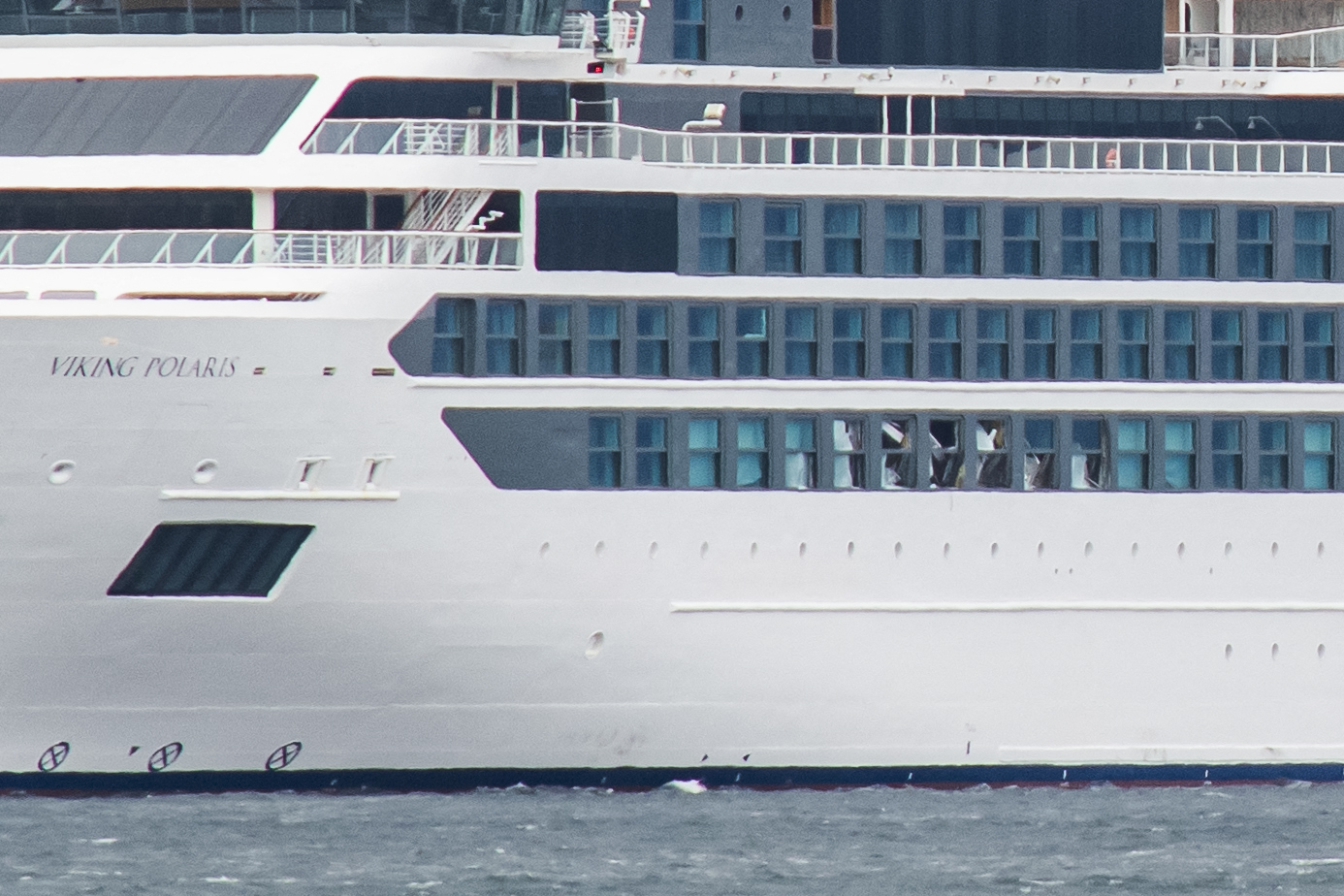
"Good Morning America" airs at 7 a.m. ET on ABC.
The Trusdales said the wave wasn't the only disaster. The Trusdales and ABC News later confirmed that a day before the accident, another passenger was seriously injured during a Zodiac boat excursion.
"It was a real loud, it was a boom, and I flew up in the air, and the passenger across from me flew up in the air. She came down and hit hard," Pam Trusdale said.
MORE: 'Rogue wave' strikes Antarctic cruise ship, leaves 1 dead and 4 injured
Tom Trusdale said he saw two passengers tossed into the air from what seemed to be an apparent explosion.
"I saw the woman go, probably about 3 feet in the air, and then the gentleman straight across from me go up in the air, and then roll over into the sea," Tom Trusdale said. "So I went across and leaned over the pontoon, and I just grabbed on to the life jacket. He was face up, so he was stabilized, and I reassured him that, 'Hey, you're safe.'"
Editor’s Picks
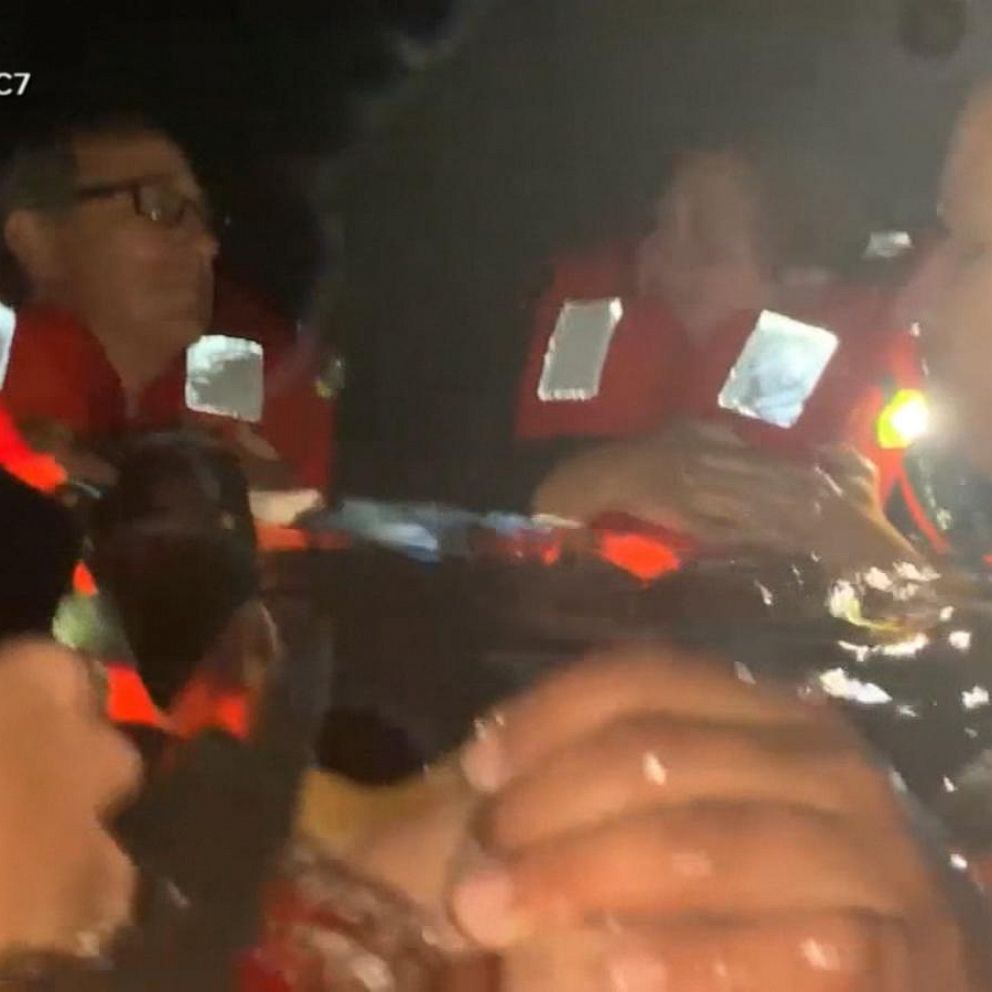
See the terrifying moments passengers leap overboard when their boat catches fire

Children of woman who died on cruise ship: 'She knew something was going to happen'

Carnival cruise passenger who went overboard speaks out
Tom Trusdale said he and another passenger were able to quickly pull the man back on the boat, but the woman's leg was severely injured.
"She said, 'I hurt my legs. I can't feel my leg,'" Pam Trusdale said. " And then I could hear her kind of straining that, you know, I could tell that she was in a lot of pain."
The passenger's leg required surgery, which led the ship's captain to turn back to Argentina. During the trip back toward Argentina, through a known turbulent stretch of ocean, was when the "rogue wave" crashed into the cruise ship.
"This wave hit it and came over and literally broke through windows and just washed into these rooms, and not only did it wash into the rooms, but it broke walls down, and once some walls went into the next room," Tom Trusdale said.
Viking said in a statement on its website that it's investigating the wave incident and is committed to the safety and security of all guests and crew.
Viking issued a second statement about the Zodiac boat incident, saying: "On November 28, the Viking Polaris deployed a small boat with six guests and one crew member near Damoy Point, Antarctica. On this trip a guest sustained a serious but non-life-threatening leg injury while on board the small boat and was taken to the medical center on the Viking Polaris."
"Following a detailed diagnosis by the ship's medical team, the decision was taken for the ship to immediately sail to Ushuaia so that the guest could receive additional medical care from a shore-based hospital," it continued. "The guest is now recovering shoreside in Ushuaia and will then return home; Viking is continuing to support them during this period. We are committed to the safety and security of all our guests and crew, and we are investigating the cause of the incident."
Related Topics
Trending reader picks.

8-year-old dies after medical emergency on flight
- Jun 13, 9:58 PM
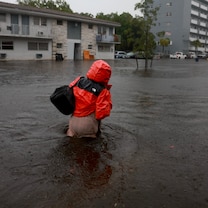
Florida met with heavy rainfall, flooding
- Jun 13, 2:08 PM

SCOTUS invalidates Trump-era ban on bump stocks
- Jun 14, 11:15 AM
SCOTUS strikes down challenge to abortion pill
- Jun 13, 11:28 AM

How Trump’s conviction will impact the election
- May 30, 5:23 PM
ABC News Live
24/7 coverage of breaking news and live events
'Rogue wave' hits Viking cruise ship, killing 1 passenger and injuring 4 others
One person died and four others were injured after a "rogue wave" hit the Viking Polaris cruise ship while it was sailing toward Ushuaia, Argentina, on Tuesday night, officials said.
“It is with great sadness that we confirmed a guest passed away following the incident,” Viking said in a statement Thursday. “We have notified the guest’s family and shared our deepest sympathies. We will continue to offer our full support to the family in the hours and days ahead.”
The name and hometown of the passenger was not released, but Argentine authorities identified her as a 62-year-old American who was hit by broken glass when the wave broke cabin windows, according to The Associated Press .
The four other guests had non-life-threatening injuries and received treatment from doctors and medical staff onboard.
Rogue waves, or extreme storm waves, are uncommon, unpredictable and "greater than twice the size of surrounding waves," according to the National Ocean Service . They are described as "walls of water" in most reports.
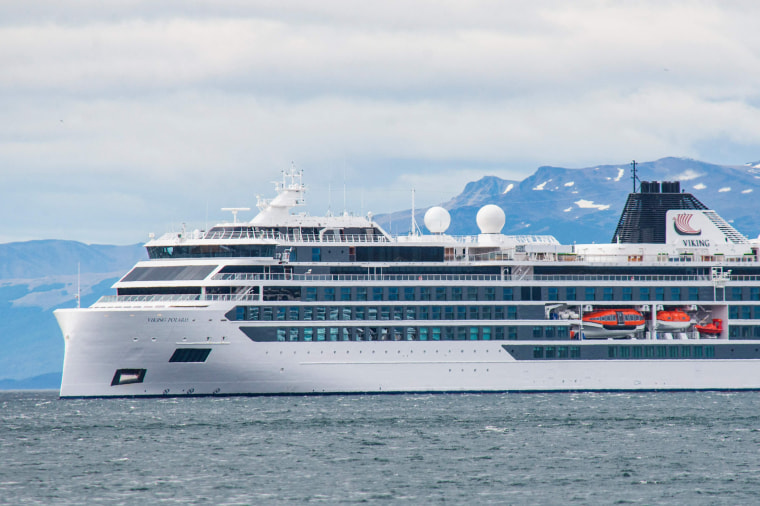
Suzie Gooding, who was on the ship when the incident happened, recalled feeling like they'd hit an iceberg, according to NBC affiliate WRAL of Raleigh, North Carolina.
“Everything was fine until the rogue wave hit, and it was just sudden. Shocking,” Gooding told the news station. “We didn’t know if we should get our gear ready for abandoning ship.”
The ship "sustained limited damage during the incident" and arrived in Ushuaia Wednesday afternoon, Viking said in its statement.
"We are investigating the facts surrounding this incident and will offer our support to the relevant authorities," the company said. "Our focus remains on the safety and wellbeing of our guests and crew, and we are working directly with them to arrange return travel."
The Viking Polaris’ next departure, the Antarctic Explorer cruise scheduled for Dec. 5-17, was canceled due to the incident.
Breaking news reporter
Watch CBS News
"Rogue wave" kills American woman, injures four others on Antarctic cruise ship
Updated on: December 2, 2022 / 7:15 PM EST / CBS/AFP
A U.S. woman died and four other passengers were injured when a massive wave smashed into an Antarctic cruise ship during a storm as it sailed off the southernmost tip of South America, officials said Friday. The 62-year-old woman was hit by broken glass when the wave broke cabin windows late Tuesday, Argentine authorities said.
The Viking Polaris cruise ship was sailing toward Ushuaia in Argentina — the main starting point for expeditions to Antarctica — when there was "a rogue wave incident," a representative of the Viking cruise company said in a statement .
"It is with great sadness that we confirmed a guest passed away following the incident. We have notified the guest's family and shared our deepest sympathies," the statement said.

Neither the Viking statement nor the Argentine Naval Prefecture identified the woman or her hometown.
In a statement to CBS News, a U.S. State Department spokesperson confirmed the death and offered condolences to the family.
"We are offering all appropriate consular assistance," the spokesperson said. "Out of respect for the family during this difficult time, we have no further comment."
Four other tourists "sustained non-life-threatening injuries" and were treated onboard, the cruise line said.
"We wondered if we hit an iceberg," Suzie Gooding, a passenger from North Carolina, told WRAL-TV . "And there are no icebergs out here, but that's how it felt."
Gooding told the station that the impact of the wave was "shocking."
"Everything was fine until the rogue wave hit, and it was just sudden. Shocking," Gooding said. "We didn't know if we should get our gear ready for abandoning ship."
Durham couple on board cruise ship struck by enormous wave, killing 1, injuring 4 https://t.co/6FIvbmV0dT — WRAL NEWS in NC (@WRAL) December 2, 2022
The ship suffered minor damage and was anchored off Ushuaia, 3,200 kilometers (nearly 2,000 miles) from the capital Buenos Aires, with several windows smashed on the side, AFP journalists reported.
Viking said it was "investigating the facts surrounding this incident."
Scientists often refer to rogue waves as extreme storm waves that surge out of nowhere, often in an unpredictable direction, and can look like a steep wall of water, up to twice the size of surrounding waves.
These rare killer waves were once seen as a myth reported by mariners or explorers. The polar explorer Ernest Shackleton wrote in his book of a "gigantic" freak wave he encountered in Antarctica in 1916.
However, scientists have learned more about them in recent decades, studying how they emerge and how to predict the wall of water that can surge up even in calm seas.
The Viking Polaris was launched in 2022 and is the newest ship in the company's fleet.
The incident comes two weeks after two tourists died on another Antarctic cruise. The two men, aged 76 and 80, had left the World Explorer ship for an excursion on an inflatable zodiac boat which overturned near the shore.
The Associated Press contributed to this report.
- Cruise Ship
More from CBS News

U.S. tourist dies, woman injured after being electrocuted in hot tub

Ship on which famed explorer died found on ocean floor

Woman dies while hiking in Colorado, prompting heat warning from officials

Woman fatally struck by police truck on South Carolina beach
A rogue wave caused a cruise ship tragedy. They occur more often than you think.

- The Viking Polaris was hit by a rogue wave in the Drake Passage, treacherous waters between Argentina and Antarctica.
- A rogue wave occurs when it's more than two times higher than waves around it. Hundreds of them have occurred over the years.
- But there's a lot to learn about these waves because they've only been confirmed by instruments within the last 30 years.
A possible rogue wave sent headlines around the world last week after it broke windows on a cruise ship off the coast of Argentina, killing a woman and injuring four others.
Such freak accidents may seem rare, but hundreds have occurred without warning around the world — on cruise ships, cargo vessels, oil platforms and beaches.
Observers often describe them as a “wall of water,” but the size of that wall is relative depending on whether you’re in a fishing boat or a cargo ship.
The six deck Viking Polaris was sailing back toward Argentina after a trip to Antarctica on Nov. 29 when a massive freak wave struck the ship. Viking Cruises called it a “rogue wave” but researchers said only further investigation will verify if it truly met the definition — more than twice as high as the average of the highest surrounding waves.
Latest climate news from USA TODAY:
- Deadly Ian: Why are predictable storms still killing so many people?
- Hurricane news : A rare December subtropical storm could form
- A batfish and a blind eel: Researchers discover deep sea creatures
Monstrous and deadly waves that arrived without warning have been recounted in fishing and sailing lore for more than a century. More modern records show how often they truly occur: Some 432 similar incidents were documented internationally between 2005 and 2021 in a catalog kept on the Russian Academy of Science’ s Institute of Applied Physics website.
Here's what to know about rogue waves.
What is a rogue wave?
Rogue waves are driven by wind. They form when waves coming from multiple directions meet at one point by chance, said Francesco Fedele, an associate professor at Georgia Tech. “It’s the constructive interference of waves coming from multiple directions. They all pile up and form this extreme event.”
They sometimes occur when waves move into strong opposing currents, such as in the Gulf Stream in the North Atlantic and off the coast of South Africa, according to the National Oceanographic and Atmospheric Administration. It can be a single wave, or a series of three or four.
It's often impossible to know if monster waves are an actual rogue wave.
A rogue wave is defined as 2.2 times higher than the waves around it, said Johannes Gemmrich, a physical oceanographer at the University of Victoria in British Columbia. The waves are measured relative to "significant wave height," determined by averaging the highest one-third of waves.
If the significant wave height is 6 feet, a rogue wave would have to be 13.2 feet. Some freakishly high waves that cause maritime disasters may be enormous, but may only be 1.9 times as high as the surrounding seas, Gemmrich said. “Unless you have measurements for an individual wave, you can’t tell if it was some rogue wave.”
More on the rogue wave off Argentina:
- Kansas residents experience two freak accidents on one cruise
- Giant 'rogue wave' hits cruise ship, leaving one dead and four injured
- Pennsylvania woman describes deadly rogue wave hitting cruise ship
What happened on the Viking Polaris?
The Polaris was in the Drake Passage , treacherous waters known for rough seas and big waves. Called the "Drake Shake" or the "Drake Lake" depending on the height of the seas, it's where the waters of the Atlantic and Pacific oceans come together between the southern tip of Argentina and Antarctica.
California sailing enthusiast Ken Spencer was a passenger on deck two, an estimated 25 feet above the water line. He told USA TODAY that waves of 20 to 25 feet were consistent in frequency and direction during the day and then turned less so into the evening, coming from mixed directions.
As he was preparing for bed, Spencer said, "this wave came directly broadside at the port side,” not from an angle like the previous waves.
“The wave had tremendous volume, and it seems to have risen as high at deck four, which is about 45 feet above the waterline," he said. "The thickness of the wave is what was amazing. The water stayed against my window for what seemed like seconds, but was likely around a second."
At the same time, the Polaris was jolted with a very powerful bump, he said.
Photos of the vessel show windows were broken in several staterooms and several rooms were breached by water. His window was intact but a few gallons of water had seeped in around the perimeter, said Spencer, who praised Viking and the vessel's crew.
How often do rogue waves occur?
Much more often than many realize.
Gemmrich estimates waves up to twice as high as the surrounding wave heights occur about every 3,000 waves and that a rogue wave may occur every 15,000 waves.
“The higher the relative wave heights increase, the more unreal the rogue waves become," Gemmrich said. “A wave three times higher than the background, that’s extremely rare.”
It’s those monster waves that occur when the background waves are 30 to 40 feet high that concern the shipping industry.
More climate news from USA TODAY:
- Conservation : Sharks, a frog and other species get new protections
- 'Things are grim': Endangered right whales continue to decline
- Is climate change fueling massive hurricanes? Here's what science says.
What's the difference between a rogue wave and a tsunami?
- A tsunami is a very long wave of seismic origin, generated by earthquakes, volcanoes and landslides. In the open ocean tsunamis have small wave heights, but in shallow water closer to the coast wave height can increase to 30-60 feet.
- Rogue waves are generated by wind and are shorter waves. Although they often occur in the open ocean, and during stormy conditions, they also occur in coastal waters.
- Meteotsunamis are typically waves smaller than tsunamis caused by air pressure disturbances in fast moving storms.
Is climate change to blame?
Some research has suggested warming temperatures are contributing to higher waves and more extreme wave heights in some regions.
The Intergovernmental Panel on Climate Change concluded with "high confidence" last year that significant wave heights are projected to increase across the Southern Ocean and tropical eastern Pacific and decrease over much of the Atlantic and the Mediterranean Sea.
However, in the North Atlantic, the panel found low confidence in projected changes in extreme wave conditions "due to limited evidence" and medium confidence that wave heights already have increased above 45 degrees latitude. Wave heights are projected to increase in the Arctic Ocean because of a reduction in sea ice.
Gemmrich said it's more likely that locations could change where rogue waves occur more often, because of shifts in storm tracks.
A lot is still unknown about rogue waves
There's still a lot to learn about rogue waves, in part because they've only been confirmed by instruments within the last 30 years. The first technical confirmation of a rogue wave took place in 1995 during a New Year’s Day storm.
An extremely large wave hit the Draupner Oil rig platform off Norway in the North Sea. The crew didn’t realize they had been hit by a rogue wave until they discovered scaffolding erected under the deck for repairs had been washed away. A laser sensor recorded the 85-foot wave, about the height of a 10-story building.
Today, satellites, radars and ocean floor sensors all help collect crucial data, but because the waves are unpredictable they're difficult to study.
Gemmrich recently concluded that the most extreme rogue wave ever recorded took place off Vancouver Island, British Columbia in November 2020. Gemmrich and a student at the University of Victoria, Leah Cicon, analyzed buoy data and found the crest measured 57.7 feet high, compared to the surrounding waves averaging 19.6 feet, nearly three times as high.
Researchers are particularly interested in solving the mysteries surrounding rogue waves, hoping to be able to provide early warnings so that shipping companies could avoid areas where dangerous conditions increase the risk.
The European Space Agency concluded in 2004 that rogue waves had sunk more than 200 vessels over the previous 20 years.
Infamous incidents likely caused by freak or rogue waves
Among the rogue wave stories recounted by mariners are two maritime disasters memorialized in film and song:
►The George Clooney thriller, “A Perfect Storm,” was based on the disappearance of the fishing vessel Andrea Gail during a nor'easter that absorbed a hurricane off Nova Scotia in 1991. Six men were lost. Canadian officials reported buoys in the area recorded peak waves in excess of 60 feet.
►The 1975 Gordon Lightfoot ballad “The Wreck of the Edmund Fitzgerald” was written after the freighter sank without a distress signal in Lake Superior during a gale on Nov. 10, 1975, killing 29 crew members.
►In 1942, the Queen Mary was hit by a 75-foot wall of water as it was taking 15,000 U.S. troops to England during World War II. It was one of at least five similar incidents along the route between 1924 and 1966.
►In August 1905, 20 of 22 crew members perished when the steamer Peconic went down off the Georgia coast.
►One hundred years later, the Norwegian Dawn cruise ship, with 3,700 passengers and crew, was headed for New York when it was hit by a series of three waves, with at least one estimated at 69 feet, during a storm off the Georgia/South Carolina coast. The force of the water sheared off aluminum rail supports and sent teak balcony railings and water through the windows of two cabins on decks nine and 10. The ship diverted course to South Carolina and the captain told people he’d never seen anything like it.
►On July 3, 1992, a wave then estimated at a height of 18 feet, struck Daytona Beach around 10:30 p.m., injuring 20 and tossing cars around. One vacationer described it as a "huge wall of white water."
Deadly 'rogue wave' smashes into cruise ship near Antarctica — but where did it come from?
A suspected rogue wave recently crashed into a cruise ship near Antarctica killing one and injuring four others. Where did it come from?
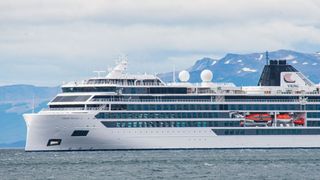
A suspected "rogue wave" recently smashed into a cruise ship sailing from Antarctica to Argentina. The freak event killed one person and injured four others. But where do these freakishly tall waves come from? And is climate change expected to make them more common or extreme?
On the night of Nov. 29, an unusually massive wave hit the cruise ship Viking Polaris as it was sailing through the Drake Passage in Antarctica's Southern Ocean toward Ushuaia, a port in Argentina where many Antarctic cruises start and end, French news agency AFP reported.
The force of the massive wall of water sent passengers flying and smashed several exterior windows, which flooded some rooms and caused further structural damage inside. A 62-year-old American woman, Sheri Zhu, was killed by injuries sustained from the broken glass and four other people received non-life-threatening injuries, according to Australian news site ABC News .
"This wave hit and came over and literally broke through windows and just washed into these rooms," Tom Trusdale, a passenger aboard the Viking Polaris when the incident happened, told ABC News. "Not only did it wash into the rooms, but it [also] broke walls down."
Related: What's the tallest wave ever recorded on Earth?
Viking, the travel company that owns the Viking Polaris, announced on Dec. 1 that the tragic event was a suspected "rogue wave incident." Upcoming cruises have been canceled until the ship can be fully repaired and a proper investigation into what happened has been carried out.
What are rogue waves?
Rogue waves are freak waves that are at least twice as high as the surrounding sea state — the average height of the waves for a given area at a given time, according to the National Oceanic and Atmospheric Administration (NOAA). The massive walls of water come from seemingly out of nowhere and without warning.
Sign up for the Live Science daily newsletter now
Get the world’s most fascinating discoveries delivered straight to your inbox.
The exact mechanisms behind the rogue waves are still unknown, but researchers think the freakish crests are formed when smaller waves merge into larger ones, either due to high surface winds or changes in ocean currents caused by storms, according to NOAA.
It is currently unclear if the wave that hit the Viking Polaris qualifies as an official rogue wave because there is no accurate data on the wave height or the surrounding sea state. A storm was raging when the wave hit, CNN reported, which could have provided the necessary conditions for a rogue wave to form. But the Drake Passage is also a notoriously treacherous part of the Southern Ocean, with deep waters that are fed by the powerful Antarctic Circumpolar Current, which makes it capable of producing very large non-rogue waves as well, according to Britannica .
— Stunning satellite image shows immense power of monster 7-story waves in Portugal
— Tsunami from dinosaur-killing asteroid had mile-high waves and reached halfway across the world
— Record-breaking Tonga volcano generated the fastest atmospheric waves ever seen
On Dec. 2, a passenger onboard another cruise ship in the Drake Passage shared a video of another massive, but less destructive, wave on Twitter .
The largest rogue wave ever recorded was the Draupner wave, an 84-foot-tall (25.6 meters) wave that was observed near Norway in 1995. However, the most extreme rogue wave ever recorded was the Ucluelet wave, a 58-foot-tall (17.7 m) wave that was detected by an ocean buoy off the coast of Vancouver Island in British Columbia in November 2020. The Ucluelet wave is regarded as the most extreme rogue wave because it was around three times higher than surrounding waves, while the Draupner wave was only around twice as tall compared with the surrounding sea state.
In 2019, a study published in the journal Scientific Reports predicted that rogue waves could become less frequent but more extreme in the future due to the effects of human-caused climate change.
Harry is a U.K.-based senior staff writer at Live Science. He studied marine biology at the University of Exeter before training to become a journalist. He covers a wide range of topics including space exploration, planetary science, space weather, climate change, animal behavior, evolution and paleontology. His feature on the upcoming solar maximum was shortlisted in the "top scoop" category at the National Council for the Training of Journalists (NCTJ) Awards for Excellence in 2023.
Earth from space: Shapeshifting rusty river winds through Madagascar's 'red lands'
Earth from space: Ethereal algal vortex blooms at the heart of massive Baltic 'dead zone'
James Webb telescope discovers most distant supernova ever seen
Most Popular
- 2 100-foot 'walking tree' in New Zealand looks like an Ent from Lord of the Rings — and is the lone survivor of a lost forest
- 3 Space photo of the week: James Webb and Chandra telescopes spot a 'lighthouse' pointed at Earth
- 4 1st Neuralink user describes highs and lows of living with Elon Musk's brain chip
- 5 James Webb telescope finds carbon at the dawn of the universe, challenging our understanding of when life could have emerged
- 2 'Physics itself disappears': How theoretical physicist Thomas Hertog helped Stephen Hawking produce his final, most radical theory of everything
- 3 1,600-year-old Hun burial in Poland contains 2 boys, including one with a deformed skull
- 4 DARPA's military-grade 'quantum laser' will use entangled photons to outshine conventional laser beams
- 5 60,000-mile-tall 'plasma waterfall' snapped showering the sun with impossibly fast fire
Cruise passenger describes the moment their ship was hit by a rogue wave: 'You could just see a wall of water, no sky or anything'
- A rogue wave smashed into a cruise ship on Thursday, causing it to lose power, Reuters reported .
- The wave struck the Norwegian ship, the MS Maud, and knocked out its navigation abilities.
- A passenger on board said that at one point, she could just see "a wall of water, no sky or anything."

The MS Maud, a Norwegian cruise ship, lost its ability to navigate after a rogue wave knocked out its power on Thursday.
The ship, operated by HX, a cruise company owned by Norway's Hurtigruten Group, was about 120 miles from Denmark's west coast when the wave struck, Reuters reported . The wave's force shattered some of the ship's windows and caused it to tilt "pretty violently," passenger Elizabeth Lawrence told Business Insider. She was one of 266 passengers and 131 crew members.
Lawrence, who had picked the cruise to see the Northern Lights, said the day started out with fairly big waves but that the captain had let passengers know to expect that. But as the day went on, the waves got bigger until they were large enough to spray her window on the sixth deck, she said.
Related stories
"The situation started with the ship's horn sounding for an extremely long time, then the PA system came on, and we just heard scuffling and general moving around noises," Lawrence said. Then, passengers heard the alarm that meant they should head to their muster stations — the place on board where guests gather in case of an emergency.
"I only had to go down a nearby flight of stairs to get to my muster station in the main restaurant, but the ship was tilting pretty violently. When it was all the way over to one side, you could just see a wall of water, no sky or anything," she told BI.
Even in moments of sheer fear, our fellow passengers found levity from the destruction of the Gingerbread Town that collapsed, fragmented & slid around us in Muster Station A Deck 5 18.19 21.12.23 #Hurtigruten #MSMaud whilst #StormPia raged around us. https://t.co/vBjwTDa3v1 pic.twitter.com/iqRkGdZGTG — Oscar Dog (@OscarWoofs) December 23, 2023
Lawrence added that while in their muster stations, passengers were given "survival suits" — or suits that "dramatically extend survival times" with insulation, per the Coast Guard .
She said they didn't get an update for about 20 minutes but that, during that time, crew members helped guests put on their suits, reassured nervous passengers, and brought out water and snacks once things had calmed down.
According to Reuters, a tow boat arrived to help the ship Thursday night. Hurtigruten told the outlet in a statement that no serious injuries resulted from the rogue wave.
"At this time, the ship has confirmed that no serious passenger or crew injuries have been sustained as a result of the incident and the condition of the ship remains stable," the statement said.
Lawrence told BI that while she probably won't head to the North Sea in the winter again, she would still cruise with HX in the future.
"The whole thing was very scary at the time, but I think everything was handled as well as possible, considering the circumstances," she said.
Watch: Cruise ship captain breaks down 8 cruise ship disasters in movies and TV
- Main content
US Citizen Killed When ‘Rogue' Wave Hit Viking Cruise Ship in Antarctic
The 62-year-old woman was hit by broken glass when the wave broke cabin windows late tuesday during a storm, argentine authorities said, by ap and staff • published december 2, 2022 • updated on december 4, 2022 at 10:34 am.
A U.S. woman was killed and four other passengers injured when a massive wave struck the Viking Polaris cruise ship while it was sailing toward the port of Ushuaia in southern Argentina on an Antarctic cruise, authorities said.
The 62-year-old woman was hit by broken glass when the wave broke cabin windows late Tuesday during a storm, Argentine authorities said. The ship suffered limited damage and arrived in Ushuaia, 1,926 miles south of Buenos Aires, the next day.
📺 24/7 South Florida news stream: Watch NBC6 free wherever you are
“It is with great sadness that we confirmed a guest passed away following the incident," Viking said in a statement. “We have notified the guest’s family and shared our deepest sympathies.”
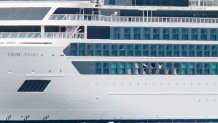
The Hurricane season is on. Our meteorologists are ready. Sign up for the NBC 6 Weather newsletter to get the latest forecast in your inbox.
Neither the statement nor the Argentine Naval Prefecture identified the woman or her hometown.
Viking called it a “rogue wave incident” and said the four other passengers' injuries were non-life threatening.
A North Carolina couple aboard the ship told NBC affiliate WRAL that they thought "we hit an iceberg" when the wave crashed into the cruise ship.
U.S. & World

Yellowstone visitors hope to catch a glimpse of rare white buffalo calf

Crews rescue 30 people trapped upside down high on Oregon amusement park ride
"There are no icebergs out here, but that's how it felt," Suzie Gooding said.
Gooding told the news station that the impact was "shocking" because it happened so suddenly.
"We didn't know if we should get our gear ready for abandoning ship," she added.
The cruise ship was anchored near Ushuaia, where a federal court has opened a case to determine what happened.
NOAA's National Ocean Service describes these "rogue" waves as "walls of water" that are often steep-sided with unusually deep troughs.
"Rogues, called 'extreme storm waves' by scientists, are those waves which are greater than twice the size of surrounding waves, are very unpredictable, and often come unexpectedly from directions other than prevailing wind and waves," the agency explains.
The company indicated on its website that to explore remote regions of the world they have “two purpose-built, state-of-the-art small expedition-class ships: Viking Octantis and Viking Polaris.”
The Viking Polaris, a vessel that has luxury facilities and was built in 2022, has capacity for 378 passengers and 256 crew members.
Shop these stylish pieces from Amazon for summer — starting at $9
- Share this —

- Watch Full Episodes
- Read With Jenna
- Inspirational
- Relationships
- TODAY Table
- Newsletters
- Start TODAY
- Shop TODAY Awards
- Citi Concert Series
- Listen All Day
Follow today
More Brands
- On The Show
- TODAY Plaza
Norwegian cruise ship loses power after it was hit by rogue wave in North Sea
A Norwegian cruise ship with more than 250 passengers on board lost power on Thursday, Dec. 21, after the vessel encountered a rogue wave during a storm, the cruise company HX said.
The MS Maud sustained a temporary loss of power while sailing to Tilbury, England, from Florø, Norway, HX said in a statement to NBC News. No serious injuries were reported among the 266 passengers and 131 crew members, according to HX.
"The condition of the ship remains stable and the crew are able to sail under their own power," a spokesperson for HX said.
The Danish Joint Rescue Coordination Centre said in a statement to NBC News the ship's crew is navigating the vessel manually via emergency systems, and that two civilian support ships are helping to navigate the waters in the North Sea .
HX said after following ongoing safety checks and technical assessments, the company amended the ship's planned route to sail to Bremerhaven, Germany, for disembarkation.
"Our team are working to arrange onward travel back home for guests onboard," a spokesperson for the company said.
The storm's hurricane-force winds smashed windows on the MS Maud, and passengers aboard described the frightening situation.
Dorothy Hallam, a passenger on board, wrote on social media, "We've been sat on the floor in our muster stations for hours wearing our safety suits and life jackets and there's no sign of us being allowed up any time soon. We were thrown about a lot."
Ian Roberts, another passenger, wrote on Facebook about the unexpected change in holiday plans.
"Sorry for those whose Christmas treat has been spoiled. However, crew on board Maud have been exemplary in looking after us in what was initially quite a tricky situation," Roberts said.
The MS Maud isn't the first ship to encounter rough seas in the North Sea — dramatic videos of huge waves crashing in the area have become a source of fascination on TikTok.
While the waters of the North Sea can be turbulent, marine experts said it's generally safe for the hundreds of thousands of ships that pass through every year.
Anna Kaplan is a news and trending reporter for TODAY.com.

Disney fans say disability program changes exclude many people who were previously covered

Remains of missing 8-month-old girl found hidden in Kentucky home

Dad convicted of serving drugged mango smoothies at daughter's sleepover says he just wanted the girls to sleep

Will King Charles be at Trooping the Colour this year? What we know so far


Kylie Kelce gives her opinion on Harrison Butker’s controversial speech

8-year-old girl dies after having medical emergency on SkyWest flight to Chicago

Kate Middleton’s cancer timeline: Diagnosis, treatment and the latest updates from the palace
Health & wellness.

Kate Middleton reveals whether she'll attend Trooping the Colour for Charles' birthday

Who is Luka Doncic's fiancée? All about Anamaria Goltes

Is Poppi good for you? Dietitians break down the pros and cons of prebiotic sodas
Diet & fitness.
- Search Please fill out this field.
- Manage Your Subscription
- Give a Gift Subscription
- Newsletters
- Sweepstakes
Norwegian Cruise Ship Loses Navigation Ability After 'Rogue Wave' Smashes Control Bridge Windows
The Norwegian cruise ship MS Maud, carrying 266 passengers and 131 crew members, suffered a power outage.
Gabrielle Rockson is a staff writer-reporter for PEOPLE. She joined PEOPLE in 2023 and covers entertainment and human interest stories. She's interviewed David Beckham, Zendaya, Timothée Chalamet and many others. Her previous work can be found in OK! Magazine, MyLondon, GRM Daily, and more.
:max_bytes(150000):strip_icc():format(webp)/Biopicture-7aed89e79c07468e879a00bb6ff007dc.jpg)
Fraser Gray/Shutterstock
A Norwegian Cruise Ship lost its navigation ability in the North Sea on Thursday after a rogue wave smashed its control bridge windows.
According to Reuters , Danish authorities and the ship's owner revealed on Thursday that the Norwegian cruise ship MS Maud, carrying 266 passengers and 131 crew members, suffered a power outage.
Meanwhile, Danish Joint Rescue Coordination confirmed that no one was harmed and the passengers and crew members were safe.
“There is no power on the ship,” the center’s spokesperson told the outlet. “The main engine is functioning but the navigation systems and radars are not."
Never miss a story — sign up for PEOPLE's free daily newsletter to stay up-to-date on the best of what PEOPLE has to offer, from juicy celebrity news to compelling human interest stories.
The center added that water entered the ship after strong winds smashed the vessel's windows while it had sailed around 200 kilometers (about 124 miles) off Denmark's west coast and 330 kilometers (205 miles) off Britain's east coast from Florø, Norway on Thursday. It had been due to arrive in the UK’s Tilbury on Friday.
“Earlier this afternoon, December 21, MS Maud reported a temporary loss of power after encountering a rogue wave,” Hurtigruten, Norwegian coastal ferry service and cruise line, said in an emailed statement, per The Guardian .
“At this time, the ship has confirmed that no serious passenger or crew injuries have been sustained as a result of the incident and the condition of the ship remains stable,” they added.
According to multiple reports, rescue company Esvagt’s support vessels helped the ship navigate until it could be pulled to port. This occurred after the vessel was manually steered from the engine room.
Per NBC News , the ship is being aided to port by two civilian support vessels and is currently traveling to Bremerhaven, Germany.
“Following ongoing safety checks and technical assessments, given the weather conditions, we decided to amend the planned sailing route,” cruise company HX said in a statement on Friday, per NBC News. “Across the fleet, there are thorough operational protocols in place and we always prioritize the safety of those onboard.”
They also added that their team is arranging the travel for guests onboard to return home.
Related Articles
- Updated Terms of Use
- New Privacy Policy
- Your Privacy Choices
- Closed Captioning Policy
Quotes displayed in real-time or delayed by at least 15 minutes. Market data provided by Factset . Powered and implemented by FactSet Digital Solutions . Legal Statement .
This material may not be published, broadcast, rewritten, or redistributed. ©2024 FOX News Network, LLC. All rights reserved. FAQ - New Privacy Policy
Cruise ship hit by rogue wave during storm, loses ability to navigate
The ms maud was hit by a 'rogue wave' en route to england from norway.
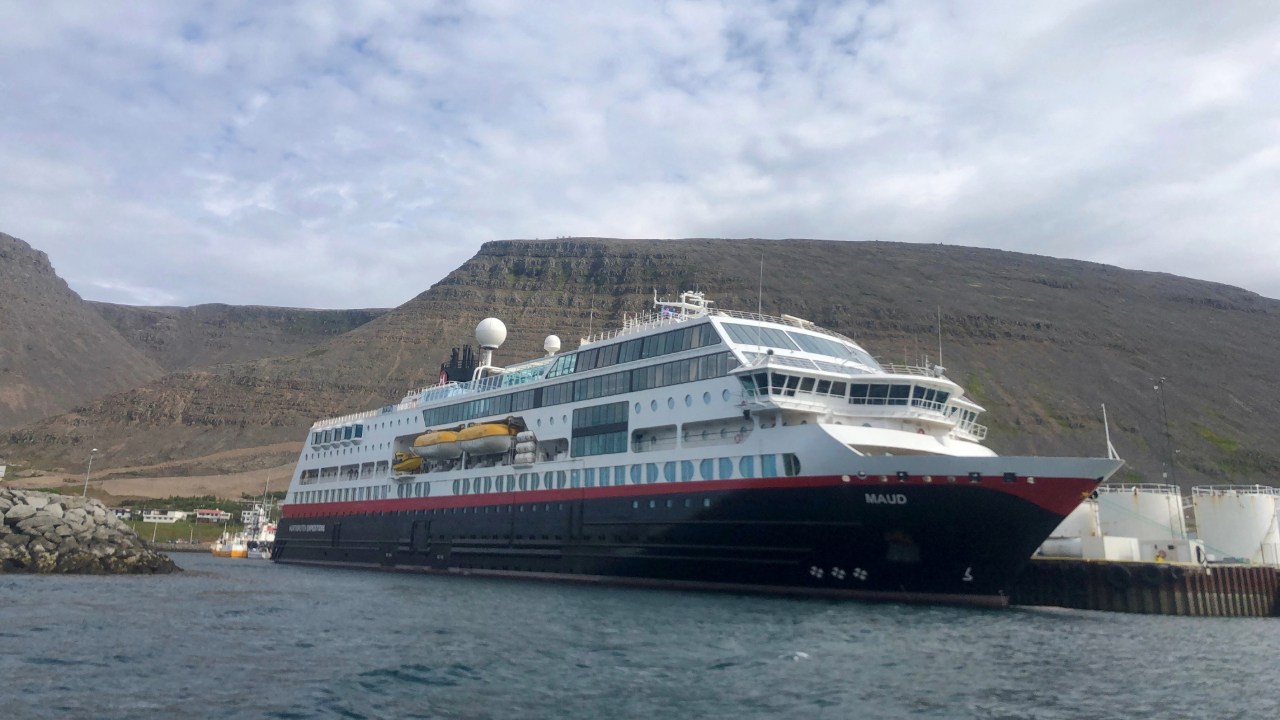
Coast Guard rescues sick Carnival Cruise passenger
The Coast Guard airlifted a passenger aboard the Carnival Legend around 180 miles off the coast of Cape Cod, Massachusetts, on Sept. 4. (U.S. Coast Guard District 1)
A Norwegian cruise ship sailing in the North Sea on Thursday lost its ability to navigate after it was hit by a rogue wave during a storm.
The MS Maud was en route to Tilbury, England, from Florø, Norway, when the wave hit, causing the vessel to temporarily lose power. While sailing roughly 120 miles off Denmark's west coast and roughly 185 off Britain's east coast, strong winds blasted windows on the bridge of the vessel, allowing water to enter and resulting in a power failure on the bridge, according to the Danish Joint Rescue Coordination Centre.
A spokesperson for HX, a unit of Norway's Hurtigruten Group, told FOX Business that the ship is sailing to Bremerhaven, Germany, for disembarkation. All 266 passengers and 131 crew members are safe.
"At this time, the ship has confirmed that no serious guest or crew injuries have been sustained as a result of the incident," the spokesperson said. "The condition of the ship remains stable, and the crew are able to sail under their own power."

A view of the MS Maud during a voyage. (Hurtigruten Group/Espen Mills)
Support vessels are working with the ship as it continues to head toward the port city in northern Germany, according to the company. Reuters reported earlier Friday, citing a Danish Joint Rescue Coordination Centre official, that another ship had assisted with a tow.
"Following ongoing safety checks and technical assessments, given the weather conditions, we decided to amend the planned sailing route," the HX spokesperson said. "Across the fleet, there are thorough operational protocols in place and we always prioriti z e the safety of those on board."
CRUISE PASSENGERS GET UGLY SURPRISE WHEN SHIP IS REROUTED TO BOSTON AND CANADA INSTEAD OF WARM BAHAMAS
Rogue waves typically "come unexpectedly from directions other than prevailing wind and waves," according to the National Oceanic and Atmospheric Administration . The larger-than-normal wave phenomenon is relatively uncommon.
CARNIVAL CRUISE CREW MEMBERS HELP RESCUE 12 PEOPLE FROM OCEAN AFTER CARGO VESSEL CAPSIZES
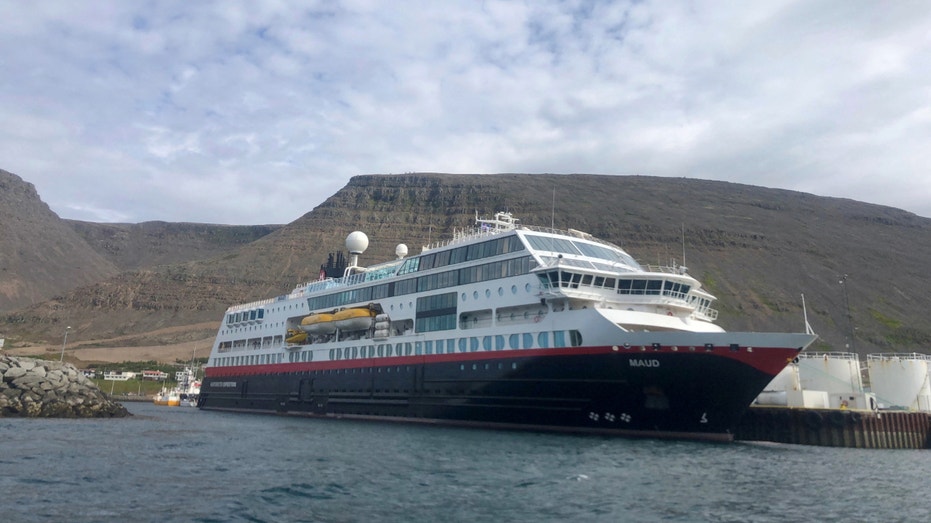
A handout image of the Norwegian cruise ship MS Maud, in Westfjords, Iceland, on July 12. (Magnus Thor Hafsteinsson/Handout via Reuters / Reuters Photos)
CLICK HERE TO READ MORE ON FOX BUSINESS
The MS Maud, built two decades ago, can carry up to 570 people, according to Hurtigruten’s website. It weighs more than 16,100 gross tons and spans 445 feet in length.
Reuters contributed to this report.

Has a Rogue Wave Ever Hit a Cruise Ship? (Can it Survive?)
Rogue waves can be huge and appear out of nowhere. If you are new to cruising or have any concerns after hearing about these freak waves, you may wonder if a rogue wave has ever hit a cruise ship. And if so, what happened? Did it survive or capsize?
We look at some of the most famous interactions between rogue waves and cruise ships, discover just how big they can be, and find out what happens if and when they ever hit a cruise ship.
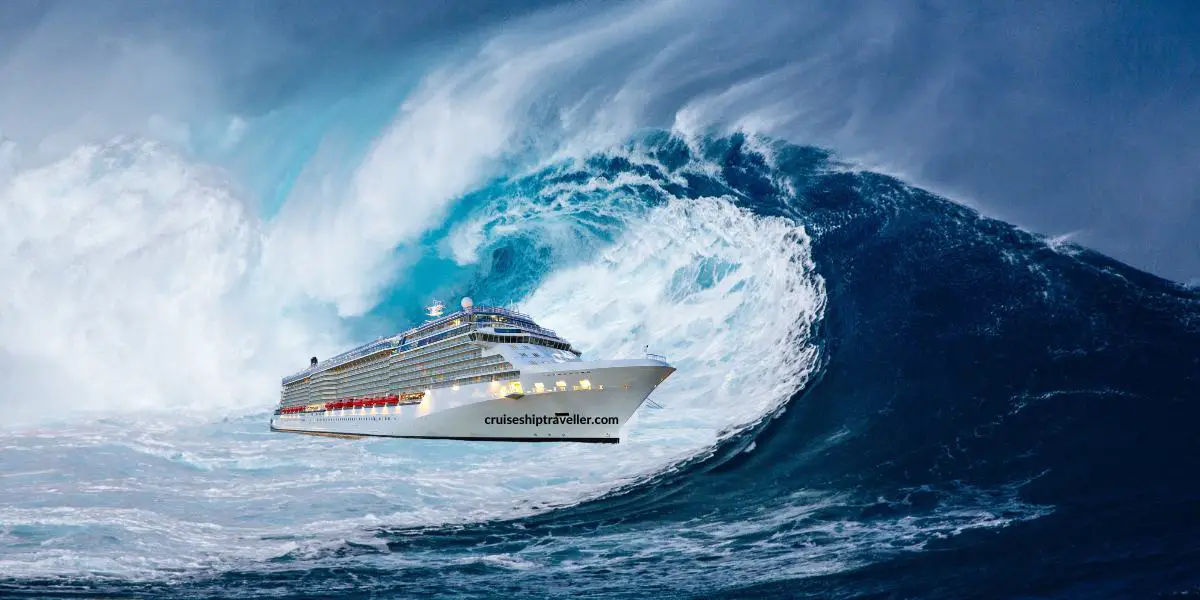
What is a Rogue Wave?
A rogue wave is a rare extra-large wave appearing on the ocean surface without warning. They are not restricted to the seas and can occur on large open-water bodies such as lakes.
Rogue waves are defined as waves that are at least two times the significant wave height of the area.
The significant wave height is the average of the largest third of waves over a given period.
This makes rogue waves significantly larger than other waves in the area.
Rogue waves can be extremely dangerous for small and large vessels such as cruise ships and even oil rigs.
Rogue waves are also known by many other names that signify huge waves, including:
- Abnormal waves
- Episodic waves
- Extreme waves
- Freak waves
- Killer waves
- Monster waves
If a rogue wave is seen on the coastline, they are sometimes called a “sneaker wave” or a “king wave” in Australia.

How Large Can Rogue Waves Be?
The rogue way that hit Queen Elizabeth 2 was estimated to be up to 96ft in height, possibly the largest rogue wave ever witnessed.
Beating that was when a fishing boat was hit in 1991, and a series of buoys in the area recorded a rogue wave at 100.7 feet .
Other accounts of rogue waves report them to be over 50ft to 70ft.
It’s quite possible more rogue ways have reached more than 100 ft in size but the odds of them ever being in the vicinity of a cruise ship are very low.
What Causes a Rogue Wave?
The causes of rogue waves are still largely unknown, but scientists believe they are caused by a combination of factors.
One theory is that rogue waves are created when two different ocean swells combine to create a larger wave. This can happen when two weather systems with different wind speeds and directions interact.
Another theory is that rogue waves can be created due to strong winds blowing over a long fetch of water. For example, if a low-pressure system moved across the ocean with high winds. The long fetch of water will create large swells which can combine to form a rogue wave.
Rogue waves aren’t just found in rough seas, they have also been known to occur in relatively calm sea conditions.
Can a Rogue Wave Sink a Cruise Ship (Or Capsize)?
Given that we have highlighted rogue waves can reach 100ft, it is entirely plausible that a rogue wave could capsize or sink a cruise ship, although the likelihood of this happening is extremely small.
The force of the water hitting the ship’s side at high speed would be enough to cause the cruise ship to tip over .
The weight of the water would also cause the ship’s hull to buckle and possibly break apart.
The pressure from the rogue wave could also cause severe damage to any windows and external features of the ship.
Inside the ship, passengers could be injured or even killed if thrown around by the force of the wave and hit by any internal objects.
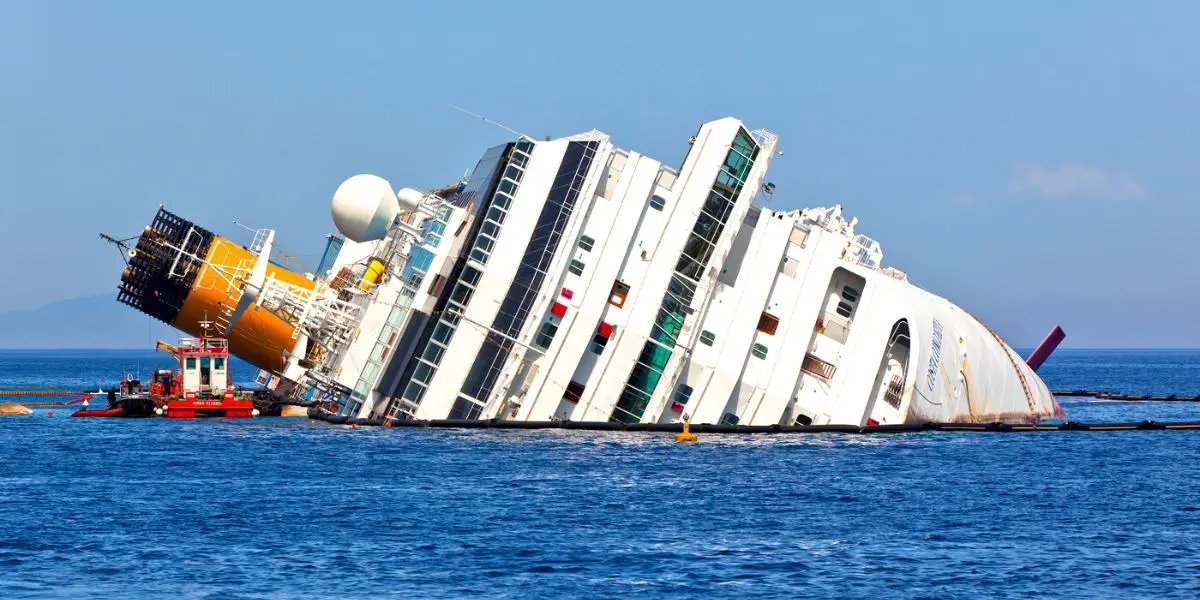
Has a Rogue Wave hit a Cruise Ship?
There have been five recorded instances of a rogue wave hitting cruise ships or passengers carrying ocean liners (QE2). There were no reported casualties, and all five ships survived to sail for many more years after.
Viking Polaris
In December 2022, an expedition cruise ship sailing on the Antarctic was hit by a rogue wave. Windows were smashed on deck 2 on the port side of the ship.
A 62-year-old passenger has died after sustaining injuries from the broken glass. 4 other passengers were treated for injuries sustained from the accident.
One of the passengers reported how the rogue wave hits the cruise ship and that it took the brunt of the wave without it rocking the ship back and forth. She was surprised at how stable it remained.
You can watch the NBC news report here:
Holland America’s MS Prinsendam
In 2007 the Holland America cruise ship MS Prinsendam (now MS Amera ) was hit by a rogue wave estimated to be 39ft high .
The ship, which at the time had a capacity of 835, was struck by a freak wave in Cape Horn, Chile. Approximately 40 people were injured, with some requiring hospitalization.
MS Bremen and MS Caledonian Star
In 2001 Bahamian-registered cruise ships MS Bremen and MS Caledonian Star were both caught in a rogue wave in the South Atlantic Ocean.
Both were hit by a rogue wave around 98 feet high . Both ships suffered damage, including smashed bridge windows and destroyed navigation and communications equipment.
The Bremen was adrift for 2 hours with no propulsion, while the Caledonian Star had to be tugged by the Argentinian Navy at the Argentine port of Ushuaia.
Both ships served many more years as sea vessels, and the Bremen is still sailing.
Queen Elizabeth 2
In September of 1995, the Cunard line Queen Elizabeth 2 ocean liner was hit by an estimated 92 to 96-foot high rogue wave caused by Hurricane Luis while crossing North Atlantic Ocean.
Although not technically cruise ships, ocean liners like the Titanic was , are built even more robustly to cope with the roughest seas on transatlantic crossings.
The freak wave hit the ship in the early hours, 200 miles off Newfoundland, as it was carrying almost 3000 passengers. The cruise captain had previously requested all passengers stay in their quarters due to the hurricane conditions, and many would have been in their beds.
The ship took an almighty hit over the bow and subsequent hits by two more large waves. Amazingly no one was injured.
Some photos of the damage, as well as first-hand experiences, can be read here .
On the page, someone who claimed to be “Chief Cashier on that Voyage” stated:
” If you saw the film The Perfect Storm and the scene with the fishing boat climbing up this enormous wave then that was us. “
Here’s a clip of the Giant wave to give you an idea of the experience that he was referring to:
MV Explorer
On the 26th of January 2005, the cruise ship MV Explorer, part of the Semester at Sea program, was hit by a 50ft rogue wave that smashed windows on the bridge, shorted navigational systems, and resulted in two engines failing.
The mid-sized cruise ship had approximately 700 students onboard at the time.
You can see a video of the aftermath and an example in our post of how a cruise ship does not tip over. Let’s just say even the aftermath was a scary experience, let alone being hit by the freak wave.
Further below, we have a video with footage the students filmed while in the ship after being hit by the freak wave.
Has a Rogue Wave Sunk a Cruise Ship?
While rogue waves are undoubtedly responsible for the sinking of smaller ships over the years, it’s very hard to know for certain if a rogue wave was the cause in many cases.
There are many accounts of ships going missing in the past without a trace, and it’s possible that some of these were due to rogue waves.
However, there have been no recorded cases of a rogue wave sinking a cruise ship.
The most likely reason for this is that technology has improved greatly over the years, and we are now better able to forecast weather and wave conditions in a way that would enable the crew and captain to take appropriate action to position the ship.
This means that cruise ships can avoid ocean areas where rogue waves are more likely to occur.
Albeit the real danger of rogue waves is that they are such sudden and unpredictable events that can appear without warning, there is only so much action a crew can take to avoid them.
Remember, in the event of a ship being damaged by a hit, cruise ships are equipped with enough liferafts and lifeboats for everyone .
Rest assured, cruise ship captains are some of the best ship captains in the world and your safety is paramount.
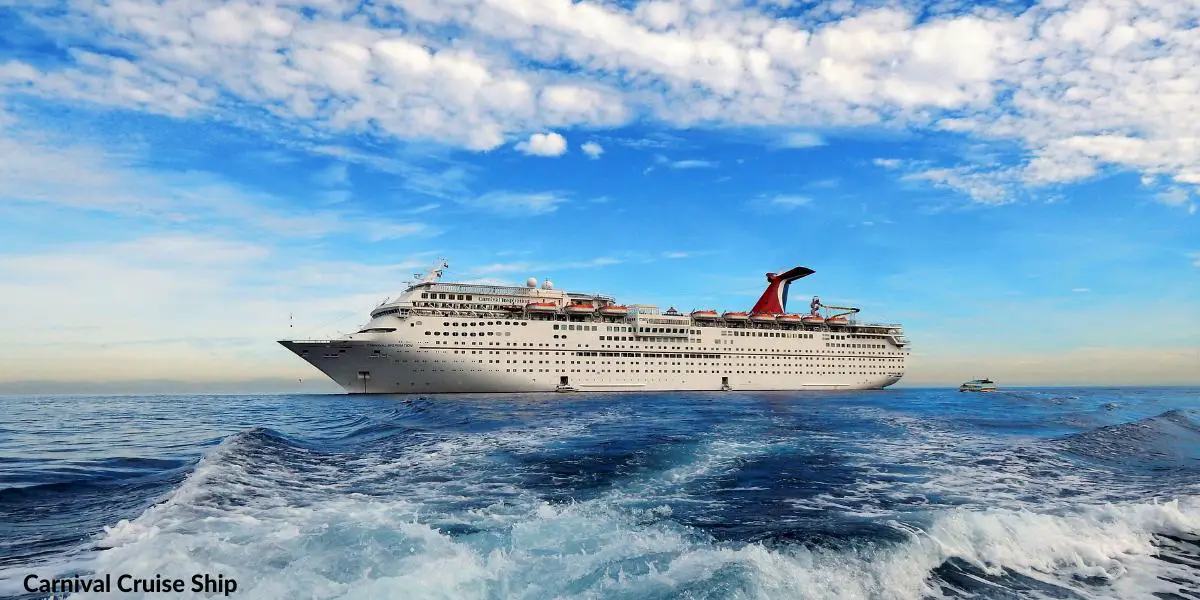
What Would Happen if a Rogue Wave Hit a Large Cruise Ship?
Many people wonder what would happen if a cruise ship was hit by one of the largest ever rogue waves.
There are many videos online of large waves hitting cruise ships, but they are just that large waves, nothing like being hit by a true rogue wave.
While there is no video evidence of a rogue wave hitting a cruise ship, the scenario has been played out on the big screen with huge modern-day cruise ships like those built by Royal Caribbean, such as Wonder of the Seas and Symphony of the Seas.
Rogue Waves Hitting Cruises Ships
For those curious this clip from the movie Poseidon shows a rogue wave hitting a cruise ship and causing it to capsize.
Although it’s worth noting, this is pure fiction, and the size of the rogue wave is highly exaggerated in relation to the size of the ship. In reality, a rogue wave has never capsized a modern cruise ship.
A huge rogue wave has hit a passenger ocean liner (Queen Elizabeth 2), which came away relatively unscathed.
What Happens After Being Hit By a Rogue Wave?
Although the video below doesn’t show the cruise ship being hit by the rogue wave, it does re-enact the moment and includes real video footage of passengers dealing with the aftermath.
How Big of a Wave can a Cruise Ship Handle?
Modern cruise ships typically handle waves of up to 50 feet.
Cruise ships typically encounter waves of 10 to 15ft without most passengers barely realizing it.
What Are the Chances of a Rogue Wave Hitting a Ship
There are typically over 310 cruise ships sailing at any given time, with an estimated 25 million people taking a cruise each year.
The odds of a rogue wave hitting a cruise ship are extremely low, which is why we never hear of the event occurring.
Rogue wave events are relatively rare given the size of the oceans combined, and when they do happen often, there are no ships within the vicinity, let alone a cruise ship.
Can a Cruise Ship Survive a Rogue Wave?
While it’s very unlikely a rogue wave will hit a cruise ship, if one did, the chances are that the ship would survive as has been the case in the real-life examples we covered above.
The design of the cruise ships keeps them afloat in the roughest of seas would see them through, although a rogue wave far exceeds the usual expectations a cruise ship is expected to encounter.
How to Survive a Rogue Wave on a Cruise Ship?
As a passenger on a cruise ship potentially being hit by a rogue wave, the safest place to be would be your stateroom, this will help protect you from being thrown around or hit by flying debris, falling decor, or sliding furniture.
Stairwells and hallways are also safer locations to gather as there is less chance of being thrown larger distances and being hit by falling or moving objects. This is where students were told to gather on the MV Explorer after it was hit by a rogue wave and the ship lost propulsion amidst very stormy seas.
If you are on deck, hold on to something sturdy and stay low to the ground.
Pay close attention to listening out for any instructions from the captain over the loudspeakers. Passengers may be asked to put on lifevests and possibly make their way to the deck with the lifeboats if abandoning the ship is a possibility.
What Size Rogue Wave can Sink a Cruise Ship?
Cruise ships come in all sizes, from carrying just a few hundred passengers to those that can accommodate over 6,000 guests.
The chance of a rogue wave sinking any size cruise ship is highly remote. The size of the rogue wave would have to be more than 70-100ft and hit the cruise at precisely the right angle. Even then, it’s possible the ship would remain afloat as they are designed to do so.
The larger the cruise ship, the more stable it is in the water and the less chance of it being sunk by a rogue wave.
The main cruise lines, Royal Caribbean, Carnival, MSC, Norwegian, Celebrity Cruises, Princess Cruises, and even Disney, have never had a ship even hit by a rogue wave and are of such sizes they should cope well if ever they were to encounter one.
However, as we covered above, one of Holland America’s cruise ships, the MS Prinsendam, was hit in 2007.
How is a Rogue Wave Different from a Tsunami?
A rogue wave is a one-off, large ocean wave that is not caused by an earthquake like a tsunami. They can appear out of nowhere and without warning but only last briefly.
Tsunamis are often caused by the movement of land, usually an ocean floor, that leads to a massive displacement of water and causes the seas to move at high speeds over a large area.
Unlike rogue waves, tsunamis can be barely noticeable on the surfaces of the seas. This makes them no threat to ships out at sea but can cause devastation to coastal areas as the waves increase in size as they come ashore.
Any cruise ships in ports or harbors would be at risk of being damaged in the path of a tsunami reaching land.
Frequently Asked Questions
Where do rogue waves occur most often.
Rogue waves are known to occur in the Atlantic Ocean, the North Sea, and the southeast coast of South Africa.
How Many Ships Have Sunk Because of Rogue Waves?
While no cruise ships have been sunk by rogue waves, other types of ships have.
One of them was the Great Lakes freighter SS Edmund Fitzgerald which is thought to have been hit by a rogues wave on Lake Superior, one of the more expensive Lakes cruises . Although thankfully, not caused any cruise ships to sink on the Great lakes.
This also highlights that rogue waves don’t just pose a risk at sea but on any open body of water.
The only other instance of a rogue wave sinking a ship was when the Andrea Gail, a fishing boat, sank on the coast of Nova Scotia in 1991 where a series of buoys reported a wave 100.7 feet high !
You can find a full list of ship and rogue events here , the vast majority of which did not sink.
How Many Ships Have Capsized Due to Rogue Waves?
Since the year 2000, they have only been a couple of reports of boats and ships capsizing by rogue waves, and neither were cruise ships.
The only ship was in November 2000 when a 56ft research vessel, the R/V Ballena, was struck by a rogue wave near Point Conception off Santa Barbara, California. The ship was destroyed, but all the crew managed to survive.
Related Posts
- How do Cruise Ships Get Into the Water – Find out how cruise ships are launched.
- Can You Fish off a Cruise Ship?
While rogue waves are an interesting topic, the chance of one hitting a cruise ship is so remote it’s not something to be of concern.
Cruise ships are designed to withstand huge waves and the roughest seas in storms, so even if a rogue wave did hit, the ship would remain afloat, and damage would be minimal.

What is the Draft of a Cruise Ship? (and Why Does it Matter?)

How Many Doors on a Cruise Ship? (Yes, I Counted)
Leave a comment cancel reply.
Your email address will not be published. Required fields are marked *
Save my name, email, and website in this browser for the next time I comment.

Why You Shouldn't Worry About Rogue Waves During Your Next Cruise
S o, you've booked your next cruise and it looks like an absolute paradise. But, rather than daydreaming about how amazing it will be, your brain suggests that you instead consider every possible thing that could go wrong. "What if a travel delay causes you to miss your cruise ?" "Should you be nervous about rough seas on your cruise ?" The list of worse-case scenarios can go on and on. This anxiety is natural and simply your brain's effort to keep you protected. But, with today's technology, safety measures, and more, traveling via cruise has never been more worry-free.
And while things can go wrong, there's a small chance that they actually will. Encountering rogue waves while at sea is a common fear that can arrive pre-departure. It is a terrifying thought that an enormous tidal wave could come out of nowhere and swallow your ship. But, science shows that this is a very unlikely reality.
Read more: The Ultimate Guide To Perfectly Packing For Your Cruise Vacation
Rogue Waves Explained
For a long time, rogue waves weren't considered anything more than an old legend rumored by sailors. However, today, they are recognized and studied by the scientific community. The National Oceanic and Atmospheric Administration defines rogue waves as " ...waves which are greater than twice the size of surrounding waves." In 1995, scientists were able to measure their first rogue wave off the coast of Norway. In this instance, an 80-foot tall wave smacked into the side of an oil rig and was captured digitally. Scientists today still don't know exactly how these mega waves form, making them highly unpredictable.
At the moment, the scientific community has hypothesized two possible causes for rogue waves. One is that swells pass over one another, coinciding and multiplying in size. Another is that storm-related water currents intersect with waves that are going in a divergent direction. Whatever the reason that rogue waves come into being, you can rest assured knowing that it is very rare that they do.
The Likelihood Of Encountering A Rogue Wave
There have been occasions in which rogue waves have actually come in contact with commercial cruise ships. In fact, this happened just in 2022. On the coast of Argentina, a cruise ship with the company Viking Polaris was hit by an enormous, powerful rogue wave. Although the ship remained afloat, the wave crashed through a series of windows. In the event, an older passenger's life was lost. In 2007, a cruise ship off the coast of Georgia in the U.S. was hit by a rogue wave seven stories high, resulting in the injury of four passengers.
In a 2019 study published by Scientific Reports, researchers found that rogue waves are becoming decreasingly common but increasingly severe. Scientists estimate that every one out of 10,000 waves is a rogue wave. Though it is a travesty that this natural phenomenon has injured and even killed cruise ship passengers, you do not have to live in fear that your cruise will have a similar fate. But, if you do want to be extra cautious, you should know that they are most common on the coast of South Africa and occur most frequently during the winter season. If you avoid cruises in that location and at that time of year, you'll have an even more minuscule chance of hitting a rogue wave.
Read the original article on Explore

- Subscribe to BBC Science Focus Magazine
- Previous Issues
- Future tech
- Everyday science
- Planet Earth
- Newsletters
Shipwrecking ‘rogue waves’ are raging through our oceans. And they have scientists puzzled
Extreme waves have recently sank cruise ships and fishing vessels .
Photo credit: Getty
Hayley Bennett
Seafaring folk have told of huge ‘rogue’ or ‘freak’ waves for hundreds of years. But it wasn’t until New Year’s Day 1995 when a 26m high surge was recorded at a gas platform in the North Sea , that scientists started taking their reports more seriously.
The extreme waves have been blamed for numerous incidents at sea. In 2018, for example, eight crew members had to be rescued when massive waves hit and sank a fishing boat off the coast of Hawaii.
More recently, a rogue wave slammed into a cruise ship in the Southern Ocean, shattering windows and injuring several passengers, one fatally. However, it remains unclear how common rogue waves actually are.
One study based on media reports captured just 210 rogue waves worldwide between 2011-2018 , but the real number is thought to be much higher.
It’s worth noting that rogue waves differ from tsunamis. The latter are large waves (or series of waves) that crash onto a coastline, usually following an earthquake or volcanic eruption under the water. Whilst tsunami waves can be tall, they are also long in profile.
Rogue waves, by contrast, have much steeper slopes and they don’t just break on shorelines – they can break in the open ocean. Technically, they’re defined as being at least twice the height of the surrounding waves, though, as University of South Florida researcher Laura Azevedo says, this definition can be misleading.
“It’s a bit of a problem because you can have a rogue wave that is one metre high and that won’t do anything to anybody,” she says.
She favours a threshold of four metres, which she says is the height at which a wave starts to become dangerous.
Exactly what triggers rogue waves is up for debate, but it’s known they’re not related to movement on the seabed. It’s thought that there are several different factors at play.
A team at the University of Oxford are attempting to understand their root causes by combining computer modelling with lab-based experiments in large tanks that use paddles to generate waves.
The team has explored the influence of sudden depth changes, simulated using a step set up in their tank.
“This is a very important problem, for example, around continental shelves, where the waves propagate from the deep ocean to coastal areas,” says team member and engineer Dr Tianning Tang . It also affects the banks created to house offshore wind turbines.
- 12 of the weirdest deep-sea creatures that lurk in the ocean's depths
- There are five oceans now, not four. A marine biologist explains why that matters…
However, the team’s results show that although depth changes do generate bigger waves, the effect is suppressed when the waves are spreading rather than all heading in the same direction. According to Tang, this means sharp drop-offs are less concerning in the ocean than in the lab, because real waves do tend to spread.
Interestingly, these results chime with what Azevedo found when studying ocean waves at Tampa Bay, Florida. Thanks to a monitoring buoy, Azevedo was able to get four years’ worth of high-quality data on wave heights at the entrance to the bay, identifying 7,593 waves meeting the technical definition of rogue waves (including 372 over four metres).
She says she “couldn’t find one specific reason” why they occurred, but they were more common when waves were travelling in one direction as opposed to spreading out.
“It’s understandable,” she says. “When you have all the energy of the sea creating that one wave, that’s a big wave.”
Her work also shows that Tampa Bay, at least, is relatively sheltered from the east, with most rogue waves coming from the west and more often when conditions are stormy or windy .
However, what causes rogue waves is not thought to be universal, so these results may only be relevant for bays comparable to Tampa’s.
All this means that it's difficult to predict when rogue waves will strike. But as understanding grows, scientists could use modelling techniques to make more accurate long-term predictions. This kind of prediction might, for example, tell the owner of an offshore wind turbine how many waves over four metres they could expect during the next 20 years in the location of their turbine.
But, as Tang notes, it’s much harder to make short-term predictions that tell crew members whether a rogue wave is going to hit their vessel in the next, say, 20 minutes.
That said, in 2016, Massachusetts Institute of Technology researchers did claim to have developed a prediction tool capable of spotting waves that could become a problem within the next 2-3 minutes.
Improved monitoring could boost efforts to understand and predict rogue waves. Right now, Azevedo says, most monitoring buoys don’t transmit maximum wave heights – they send ‘significant wave height’, which is an average of the tallest 33 per cent of waves over a given period.
“So you’re missing the big waves,” she says, adding that this would be simple to change. Better data could help those involved in designing and building for the open ocean to account for extreme waves – which, by some estimates, are already increasing due to climate change .
Azevedo suggests one solution could be for ship designers to make their ships resilient enough to withstand double the significant wave height, though they’d no doubt need some convincing due to the increased costs.
About our experts
Laura Azevedo is a graduate student based at The University of South Florida's College of Marine Science. Her work focuses on meteorological, oceanographic and weather data. Her work has been published in the journals Limnology and Oceanography and MDPI .
Dr Tianning Tang is a postdoctoral researcher based at The University of Oxford, where he specialises in machine learning. His work has been published in journals including the Journal of Fluid Mechanics , Applied Ocean Research and Ocean Engineering .
- 12 weird creatures found in the oceans' depths
- Is it true that the Pacific and Atlantic oceans don't mix?
- 11 dazzling images of the UK's vibrant ocean wildlife
Share this article

- Terms & Conditions
- Privacy policy
- Cookies policy
- Code of conduct
- Magazine subscriptions
- Manage preferences

An official website of the United States government
Here’s how you know
Official websites use .gov A .gov website belongs to an official government organization in the United States.
Secure .gov websites use HTTPS A lock ( Lock A locked padlock ) or https:// means you’ve safely connected to the .gov website. Share sensitive information only on official, secure websites.
- JetStream home
- Layers of the Atmosphere
- Air Pressure
- The Transfer of Heat Energy
- Energy Balance
- Hydrologic Cycle
- Precipitation
- Layers of the Ocean
- Ocean Circulations
- The Sea Breeze
- The Marine Layer
- Rip Current Safety
- Global Atmospheric Circulations
- The Jet Stream
- Climate vs. Weather
- Climate Zones
- How clouds form
- The Core Four
- The Basic Ten
- Cloud Chart
- Color of Clouds
- Parcel Theory
- Stability-Instability
- Radiosondes
- Skew-T Log-P Diagrams
- Skew-T Plots
- Skew-T Examples
- Pressure vs. Elevation
- Longwaves and Shortwaves
- Basic Wave Patterns
- Common Features
- Thickness Charts
- Weather Models
- Surface Weather Plots
- Norwegian Cyclone Model
- Types of Weather Phenomena
- Electromagnetic waves
- The Atmospheric Window
- Weather Satellites
- How radar works
- Volume Coverage Patterns (VCP)
- Radar Images: Reflectivity
- Radar Images: Velocity
- Radar Images: Precipitation
- Inter-Tropical Convergence Zone
- Classification
- NHC Forecasts
- Hazards & Safety
- Damage Potential
- ENSO Pacific Impacts
- ENSO Weather Impacts
- Ingredients for a Thunderstorm
- Life Cycle of a Thunderstorm
- Types of Thunderstorms
- Hazard: Hail
- Hazard: Damaging wind
- Hazard: Tornadoes
- Hazard: Flash Floods
- Staying Ahead of the Storms
- How Lightning is Created
- The Positive and Negative Side of Lightning
- The Sound of Thunder
- Lightning Safety
- Frequently Asked Questions
- Types of Derechos
- Where and When
- Notable Derechos
- Keeping Yourself Safe
- Historical Context
- Causes: Earthquakes
- Causes: Landslides
- Causes: Volcanoes
- Causes: Weather
- Propagation
- Detection, Warning, and Forecasting
- Preparedness and Mitigation: Communities
- Preparedness and Mitigation: Individuals (You!)
- Select NOAA Tsunami Resources
- Weather Forecast Offices
- River Forecast Centers
- Center Weather Service Units
- Regional Offices
- National Centers for Environmental Prediction
- NOAA Weather Radio
- NWS Careers: Educational Requirements
- Weather Glossary
- Weather Acronyms
- Learning Lessons
- "A Funny Bath"
- Keeping Current
- Anatomy of a Wave
- Beaufort Wind Scale
- Bay of Fundy
The wind not only produces currents, it creates waves. As wind blows across the smooth water surface, the friction or drag between the air and the water tends to stretch the surface. As waves form, the surface becomes rougher, making it easier for the wind to push the water surface and intensify the waves.
Take it to the MAX! Anatomy of a Wave
Wind waves are higher frequency waves generated near the wind source (frequency is the number of waves that pass a point in a specific amount of time). How big wind waves get depends on three things:
- Wind strength. The wind must be moving faster than the wave crests for energy to be transferred.
- Wind duration. Strong wind that blows for a long period will generate large waves.
- Fetch. This is the uninterrupted distance over which the wind blows without significant change in direction. (For example, storms of equal size can generate much larger waves in the open Pacific Ocean as compared to the other oceans due to the long open distance of water.)
After the wind has blown for a while, the waves get higher from trough to crest, and both the wavelength and period become longer. As the wind continues or strengthens, the water first forms whitecaps and eventually the waves start to break. This is referred to as a fully developed sea.
Take it to the MAX! Wind and Sea Scales
In the book Oceanography and Seamanship , William G. Van Dorn provided an example of what the wave heights would be if a steady 30 knot (33 mph/53 km/h) wind blew for 24 hours over a fetch of 340 miles.
- 10% of all waves will be less than 3.6 ft. (1 m ).
- The most frequent wave height will be 8½ ft. (2½ m).
- The average wave height will be 11 ft. (3 m).
- The significant wave height will be 17 ft. (5 m).
- 10% of all waves will be higher than 18 ft. (5 m).
- The average wave height of the highest 10% of all waves will be 22 ft. (7 m).
- A 5% chance of encountering a single wave higher than 35 ft. (11 m) among every 200 waves that pass in about 30 minutes.
- A 5% chance of encountering a single wave higher than 40 ft. (12 m) among every 2,600 waves that pass in about five hours.
The waves in a fully developed sea outrun the storm that creates them, traveling great distances from the wind source and lengthening and reducing in height in the process. These lower frequency waves are called swell waves. Swells organize into groups smooth and regular in appearance. They are able to travel thousands of miles unchanged in height and period.
The longer the wave, the faster it travels. As waves leave a storm area, they tend to sort themselves out with the long ones ahead of the short ones, and the energy is simultaneously spread out over an increasingly larger area.
As the waves close in on the coast, they begin to interact with the bottom, and their direction of travel might change due to the contour of the land. Eventually, the waves run ashore, increasing up to 1.5 times their height in deep water, finally breaking up as surf.
Big wave surfing in Hawaii is possible because of swell waves generated from large winter Pacific Ocean storms from November through March.
Rogue Waves
There are many sailor tales of "rogue waves", "freak waves", "three sisters", and other "killer waves". Properly called "extreme storm waves", these tales were ridiculed, and mariners were accused of using them as an excuse to cover their own mistakes in wrecks. Rogue waves are simply unusually large waves appearing in a set of smaller waves.
Some of the characteristics of rogue waves are:
- Their height is greater than twice the size of surrounding waves,
- They often come unexpectedly from directions other than prevailing wind and waves and, most importantly,
- They are unpredictable.
Most reports of extreme storm waves say they look like "walls of water" and are seen as steep-sided with unusually deep troughs. The USS Ramapo reported one such wave with a height of 112 feet in the Pacific in 1933. Another report of a freak wave occurred when it struck the Queen Mary amidships, south of Newfoundland, at the end of World War II, rolling her to within a degree or two of capsizing.
In April 2005, a 70-foot wave crashed down on the Norwegian Dawn cruise ship. The average waves that day were 25 to 30 feet high before this monster wave struck. The wave even damaged the ship's hull.
What causes these enormous waves? Swells traveling across the ocean do so at different speeds and directions. As these swells pass through one another, their crests, troughs, and lengths happen to coincide and reinforce each other, combining to form unusually large waves which reach tremendous heights, then disappear. If the swells are traveling close to the same direction, these mountainous waves may last for several minutes before subsiding.
It is very seldom that huge waves over 65 feet (20 meters) develop, and normally sailors do not even see them because ships nowadays will try to avoid such conditions by altering course before the storm hits. But they do occur.
"Stolt Surf", North Pacific 1977
The following images are from the chemical tanker ship "Stolt Surf", built in 1970, caught in a large storm in the North Pacific Ocean. The largest waves of the storm broke over the Bridge, more than 72 feet (22 meters) high. Images © Karsten Petersen. Used by permission.
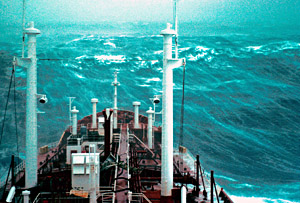

IMAGES
VIDEO
COMMENTS
Dec. 3, 2022. A passenger died and four others were injured after a large, unexpected wave hit a cruise ship traveling toward a popular launching point for expeditions to Antarctica, Viking ...
A Norwegian cruise ship lost the ability to navigate after a rogue wave crashed into it Thursday, the cruise company HX said. The MS Maud lost power after the wave hit as the ship was sailing ...
The storm caused a giant wave that broke several panes of glass on the cruise ship and these fell onto and killed an American woman. Viking Cruises confirmed in a statement issued Saturday that ...
Courtesy Beverly Spiker. An American passenger on an Antarctic cruise died and four other guests were injured after their Viking ship was struck by a "rogue wave," officials said. The incident ...
MORE: 'Rogue wave' strikes Antarctic cruise ship, leaves 1 dead and 4 injured. Tom Trusdale said he saw two passengers tossed into the air from what seemed to be an apparent explosion.
0:00. 0:50. One person died and four others were injured after a giant "rogue wave" hit an Antarctica-bound cruise ship, travel company Viking said. The "rogue wave incident" occurred during a ...
A cruise ship in the North Sea was hit by a massive rogue wave, causing a power outage and disabling the vessel's navigation system late on Thursday, Danish authorities said, as a deadly storm ...
One passenger was killed and four more injured after a "rogue wave" hit a cruise ship bound for Antarctica, travel company Viking has said. The Norwegian-flagged Viking Polaris was caught in a ...
Dec. 2, 2022, 10:13 AM PST. By Mirna Alsharif. One person died and four others were injured after a "rogue wave" hit the Viking Polaris cruise ship while it was sailing toward Ushuaia, Argentina ...
American killed after "rogue wave" hits Antarctic cruise ship 00:21. A U.S. woman died and four other passengers were injured when a massive wave smashed into an Antarctic cruise ship during a ...
An expedition cruise ship temporarily lost power after it was hit by a rogue wave on Thursday.. There were no serious injuries among guests or crew members aboard the MS Maud vessel, operated by ...
A rogue wave is defined as 2.2 times higher than the waves around it, said Johannes Gemmrich, a physical oceanographer at the University of Victoria in British Columbia. The waves are measured ...
The Viking Polaris, a Norwegian-flagged cruise ship, is seen anchored by Ushuaia, southern Argentina, on Dec. 1, about two days after a suspected rogue wave hit it, killing one passenger. (Image ...
The MS Maud, a Norwegian cruise ship, lost its ability to navigate after a rogue wave knocked out its power on Thursday. The ship, operated by HX, a cruise company owned by Norway's Hurtigruten ...
A U.S. woman was killed and four other passengers injured when a massive wave struck the Viking Polaris cruise ship while it was sailing toward the port of Ushuaia in southern Argentina on an ...
The Norwegian cruise company Viking said the ship was battered by a "rogue wave" that smashed several panes of glass in the cabins. "We wondered if we hit an iceberg. And there are no icebergs ...
Passengers on the Antarctica cruise ship are speaking out after the ship was hit by a "rogue wave" last week, killing an American passenger, Sheri Zhu, and i...
A Norwegian cruise ship with more than 250 passengers on board lost power on Thursday, Dec. 21, after the vessel encountered a rogue wave during a storm, the cruise company HX said. The MS Maud ...
A Norwegian Cruise Ship lost its navigation ability in the North Sea on Thursday after a rogue wave smashed its control bridge windows. According to Reuters, Danish authorities and the ship's ...
A Norwegian cruise ship sailing in the North Sea on Thursday lost its ability to navigate after it was hit by a rogue wave during a storm. The MS Maud was en route to Tilbury, England, from Florø ...
Holland America's MS Prinsendam. In 2007 the Holland America cruise ship MS Prinsendam (now MS Amera) was hit by a rogue wave estimated to be 39ft high. The ship, which at the time had a capacity of 835, was struck by a freak wave in Cape Horn, Chile. Approximately 40 people were injured, with some requiring hospitalization.
The video shows the rogue wave ahead of the Otto Sverdrup off the coast of Germany on Friday. The ship is over 450 feet long, 70 feet wide, almost 16,000 tons, and has eight decks, and still, the ...
On the coast of Argentina, a cruise ship with the company Viking Polaris was hit by an enormous, powerful rogue wave. Although the ship remained afloat, the wave crashed through a series of windows.
Scientists are still uncertain how freak waves arise that can overturn boats and ships.
Rogue waves are simply unusually large waves appearing in a set of smaller waves. Some of the characteristics of rogue waves are: ... In April 2005, a 70-foot wave crashed down on the Norwegian Dawn cruise ship. The average waves that day were 25 to 30 feet high before this monster wave struck. The wave even damaged the ship's hull.
Find breaking cruise news updated daily. The latest cruise news can help you pick the right cruise using over 313,175 cruise reviews by travelers and cruise experts.